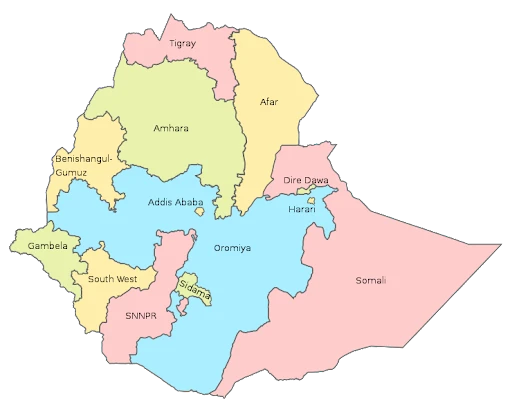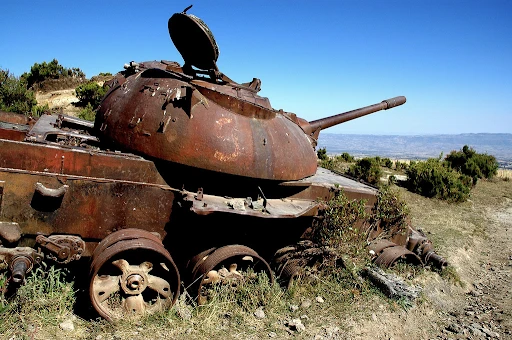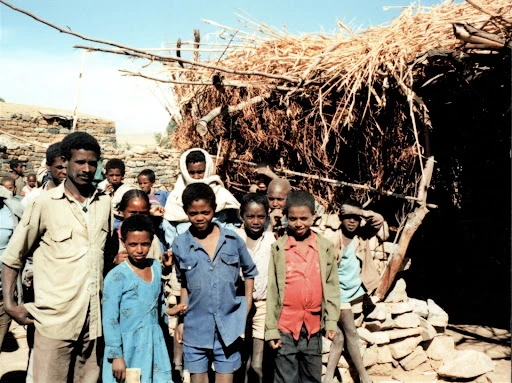Cameron Bonner already had experience as a Peace Corps Volunteer in Ethiopia (1967–1969) when he chose to return to the country for a teaching position at Addis Ababa University. Yet Bonner encountered a difficult political and social environment when he arrived in late 1975. Violent civil and political unrest, coupled with recurring and widespread drought emergencies, completely changed his career path that started from the cancellation of his job university offering to working to establish a county-wide drought and famine early warning system with the Ethiopia government’s Relief and Rehabilitation Commission (RRC). This 2-year position ended when in 1978 he joined the USAID Mission to Ethiopia as a direct-hire General Development Officer.
Back in 1974, Ethiopian military officers, exhausted by the long-simmering campaign of secession in Eritrea (still then a province of Ethiopia) and anger over the government’s coverup of drought and famine conditions starting in the early 1970s, staged a coup, leading to the creation of the Provisional Military Administrative Council, commonly known as the Derg. The Derg established the RRC to act as an early famine warning system across the country, although northern peasants most vulnerable to drought had little control over the RRC’s response mechanisms. Bonner worked with the RRC in order to develop a competent, country-wide monitoring and early warning system on drought preconditions. However, the vulnerability to famine only worsened as the Derg forcibly displaced farmers in the north to more arable lands in the southern provinces.
Drought conditions and crop failures continued as socialist and collectivist agriculture policies exacerbated food security conditions both in the north and elsewhere. Furthermore, the locations of the government’s military campaigns corresponded with the most famine-stricken regions, especially as their operations resulted in disruption of areas producing a food surplus. Market bombings, forced population relocations, restricted peasant mobility, and misdirected humanitarian relief all contributed to widespread discontent. Unfortunately, as the violence worsened and widened, and as US legislative constraints on development assistance to the country were enforced, Bonner and most direct-hire USAID staff were forced to leave the country in 1979.
Despite Bonner’s truncated experience in Ethiopia, he would continue to work within the USAID Foreign Service for almost two more decades and across three different countries, including Washington, DC. He finally made his return to Ethiopia as a USAID Education Officer in 1993 following the overthrow of the Derg and the conclusion of the country’s civil war. There he formulated the Basic Education System Overhaul (BESO) program, combining project and non-project modalites to restructure and decentralize Ethiopia’s educational system, which was viewed by many, especially villagers, as venues for propaganda and conscription. After his retirement in 1997, Bonner continued as a freelance consultant to assist USAID’s education work in Ethiopia as well as other countries in Africa, Eastern Europe, and South Asia.
Cameron Bonner’s interview was conducted by Marcia Bernbaum on March 9, 2022.
Read Cameron Bonner’s full oral history HERE.
Drafted by Michael Skora
ADST relies on the generous support of our members and readers like you. Please support our efforts to continue capturing, preserving, and sharing the experiences of America’s diplomats.
Excerpts:
“The winds of change were growing”
Changing winds in Ethiopia:
Q: Can I ask you what the political situation was at the time? Who was in power and how that affected you, if at all?
BONNER: During our Peace Corps days in Ethiopia, Haile Selassie was the emperor. The trappings of his regime were seen everywhere, from his ornate palace in Addis, to his ever-present security forces, to the domination of his feudal-like administration in the outlying provinces. As volunteers, teaching in the small town of Asebe Teferi––which interestingly

translates as “Think of Teferi,” a reference to Haile Selassie as a young regent, known as Teferi Makonnen––we were isolated from the politics and governance of the day. But when assigned to the capital, we encountered more evidence of his ever-present influence and would hear rumors of dissent among various ethnic groups––the Oromo, Tigrayans, Gurages, Afaris, et cetera––who felt under- or mis-served by the emperor’s favored Amhara governing elites. The winds of change were growing, but it took another five years and a severe drought before he was deposed in a military coup, bringing to power the much worse and horrific regime of self-proclaimed communist, Lt. Col. Mengistu Haile Mariam.
As volunteers, teaching in the small town of Asebe Teferi––which interestingly translates as “Think of Teferi,” a reference to Haile Selassie as a young regent, known as Teferi Makonnen––we were isolated from the politics and governance of the day. But when assigned to the capital, we encountered more evidence of his ever-present influence and would hear rumors of dissent among various ethnic groups––the Oromo, Tigrayans, Gurages, Afaris, et cetera––who felt under- or mis-served by the emperor’s favored Amhara governing elites. The winds of change were growing, but it took another five years and a severe drought before he was deposed in a military coup, bringing to power the much worse and horrific regime of self-proclaimed communist, Lt. Col. Mengistu Haile Mariam.
“The coup against the emperor had taken place, civil unrest was increasing, strict curfews were imposed, and the university was shut down due to student protests.”
Joining the Relief and Rehabilitation Commission:
In December 1975, my wife and I returned to Ethiopia, where she had just been assigned a position in the USAID mission. Before leaving the US, I applied for and was accepted to a teaching job in the Mathematics Department of Addis Ababa University (at the time called Haile Selassie the First University). I said, “Okay, I’m fine with going back to teach math at the college level.” And so that became our plan. I would be teaching at the university; Marge working as an intern with USAID. Then, things fell apart.
The coup against the emperor had taken place, civil unrest was increasing, strict curfews were imposed, and the university was shut down due to student protests. So I didn’t have a job after all. But I still had a job taking care of our young son, fortunately with household help. Within a few months, I got a job teaching math at the Sanford School, a private school catering mainly to children of British and other expatriates. I taught high school math there for about a year, but it wasn’t professionally rewarding. But good fortune returned: I was offered a USAID-funded contract to work for the Government of Ethiopia’s Relief and Rehabilitation Commission (RRC) to help establish a country-wide early warning system to monitor and report on the preconditions of drought. Ethiopia had just gone through the horrible 1974 drought and famine, which was viewed as one of the proximate causes of the emperor’s overthrow, so the new government was very keen to deal with future food insecurity issues in a more effective way. RRC needed somebody to do statistical analyses and technical report writing, all of which had to be in English to be shared with the foreign donor community. So, I got a contract with RRC, funded by USAID. I worked directly with the Ethiopian government and did that for a year and a half or so. But then, the opportunity came along for a direct-hire USAID position; they were hiring and I was interested. I applied. I was accepted.
“. . . . when I would show up in the morning, there would be a dead body or two lying not so far from my office.”
Political dangers force Bonner into leaving the RCC and formally joining USAID:

BONNER: I just wanted to set the scene in Ethiopia. I mentioned that I was working for the Relief and Rehabilitation Commission (RRC) under a USAID contract. The situation in the country was bad and getting worse weekly. In front of my office block at the RRC, which was separate from USAID offices across town, there would occasionally be extrajudicial killings during the night, and when I would show up in the morning, there would be a dead body or two lying not so far from my office.
It was a very, very scary time, Haile Selassie had been overthrown by a military coup, led by Lieutenant Colonel Mengistu Haile Mariam, who was a devoted communist-socialist. He felt very much threatened by the possibility of a rebellion to the coup, and he employed a lot of violent actions as a result. The political and living environment was very difficult, especially in the capital. The personal security situation––not directed at me as a foreigner––for all of my Ethiopian colleagues was extremely tough. And it was some of that difficulty that led to my quitting RRC and to join USAID.
The other factor was that given the problems with finding work when I arrived in Ethiopia, I was attracted to the job security that USAID would offer. I was thinking of the future. Do I really want to follow Marge around in her career and then have to scramble for a job in each new country she would be assigned to? Or should I try to become an employee in my own right, and endeavor to get joint assignments as a spouse-couple? And that’s what I decided to do. But it was not an easy decision, and I’ll tell you why.
Since I was abroad, I could not be interviewed in Washington, so USAID/W agreed that I should be interviewed by mission personnel. And because I had been in Ethiopia at that time for about two years, I knew most of the USAID direct-hire staff. Maybe because of this, or maybe not, this was an easy series of interviews. With one exception: there was one person in the mission, an economist, who said he was not necessarily in favor of having a spouse of a USAID employee hired, because that would take opportunity away from a household that only had one income source. To me, this was a typical economist response. But anyway, I always remember that and wondered about it. I initially felt a little uncomfortable, whether I am taking the job away from a more deserving, economically deserving person.
But the mission support was strong. I remember, however, one thing during the set of interviews that gave me pause, and it continued to intrigue me over my career with USAID. The interviewer said, “With RRC, you’re now working directly in the field; the impact of the efforts you are making you can see on a daily basis. And right now, you are typical of the people USAID hires under contract to actually implement its development programs.

If we employ you as an intern, and then you become a USAID officer, you’re not going to have such direct involvement with the impacts of your efforts. You’ll have to step back, taking a more hands-off role, acting as a wholesaler rather than retailer of development interventions.
TABLE OF CONTENTS HIGHLIGHTS
Education
BA in Mathematics, Rutgers University–Newark, 1961–1965
MA in Mathematics, City University of New York, 1965–1967
Ph.D. in Mathematics Education, University of Illinois at Champaign-Urbana, 1972–1974
Joined USAID Foreign Service 1978
Addis Ababa, Ethiopia—USAID Multi-sectoral Development Office, General Development Officer, 1978–1979
Dar es Salaam, Tanzania—Human Resources Development Office, General Development Officer, 1980–1983
Jarkarta, Indonesia—Human Resources and Institutional Development Office, Chief, 1983–1988
Washington, DC—USAID, Africa Bureau, Chief, Education Division; Chief; Education & Health Division; Deputy Director, Analysis, Research, and Technical Support Office, 1988–1993
Addis Ababa, Ethiopia—USAID/Ethiopia Education and Human Resources Office, Chief, 1993–1997
